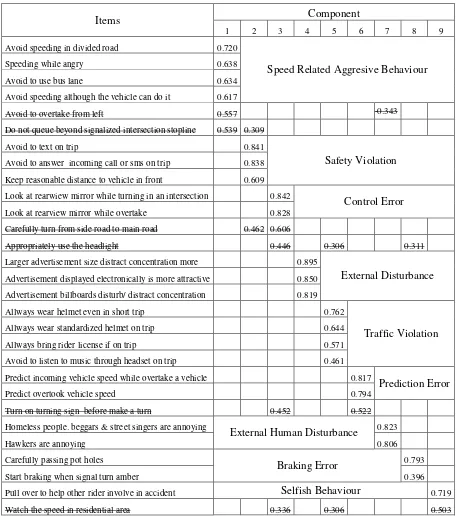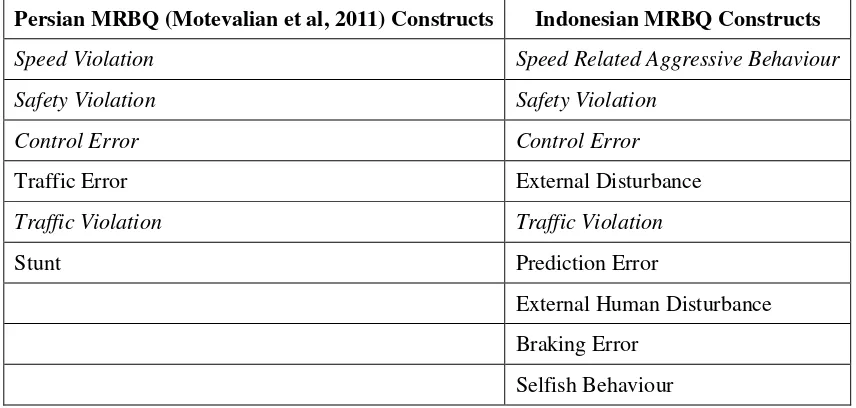Initial Development of Indonesian Motorcycle Rider Behaviour Questionnaire
The use of motorcycle in Jakarta increased rapidly in the last ten years. This is due to lack of sufficient public transport services. The public tried to overcome the congestion problem individually by using motorcycle. Among the daily users of motorcycles were university students. This paper dicusses the development of motorcyclist behaviour questionnaire in Indonesian context. Interviews were conducted to 100 male motorcyclists and 50 female motorcyclists. All respondents were Tarumanagara University students in Jakarta. The questionnaire consists of 31 statements reflecting motorcylist behaviour. The statements were the result of of focus group discussion among researchcers in this topic. Respondents were asked to rate whether they strongly agree (1), agree (2), disagree (3) or strongly disagree (4) to each statement. The collected data were analyzed using exploratory factor analysis (EFA).
Keywords: motorcyclist behaviour questionnaire, university students, exploratory factor analysis
1. INTRODUCTION
In the last ten years congestion in Jakarta, Indonesia became worse. This is due to unctrolled city development and lack of sufficient public transport system. As the public felt that the government did not overcame this problem seriously, they tried to find instant individual “solution” by riding motorcycle daily that allow them to find gap in a congested roads, ease them to find parking space and relatively affordable in terms of ownership, maintenance and operation cost. University students ride motorcycle daily. In this paper only the students from Tarumanagara University, Jakarta were observed.
2. PREVIOUS STUDIES
As motorcycle is not a daily mode of road transport in most countries, previous journal papers on motorcycle rider behaviour questionnaire were limited. Persian Motorcycle Rider Behavious Questionnaire (MRBQ) was developed by (Motevalian et al, 2011). It consists of 48 items reflecting six subscles, i.e. speed violation, traffic errors, safety violations, traffic violations, stunts and control errors. Four years earlier Elliott et al (2007) develop MRBQ to predict motorcycle crash risk in Great Britain. It was following Driver Behaviour Questionaire (DBQ) developed by Reason et al (1991) in classifying driver behaviour into errors and violations subscales. Traffic errors were the main predictors of crash risk according to Elliot et al (2007).
and just go for it on country roads, etc. Examples of performing stunts and other high risk behaviours are attempt to do, or actually do, a wheelie; intentionally do a wheel spin, etc. Examples of control errors are run wide when going round a corner; brake or throttle back when going round a corner or bend; find that you have difficulty in controlling the bike when riding at speed. In a studi on Risk and Motorcyclist in Scotland, Sexton et al (2006) divided the interview instrument into three main sections i.e. motorbike and riding experience, risk and attitudes, and risk and enjoyement factors.
Behaviour questionnaires were sensitive to culture difference. For example, Fergusson and Horwood (2000) modified Driver Behaviour Qoestionnaire (DBQ) developed by Reason et al (1991) to Reflect New Zealand condition. Xie and Parker (2002) considered Chinese culture di developing Chinese DBQ. Similarly Lajunen et al (2004) considered local culture when using Manchester DBQ in safety research in the Netherland and Finland. Persian MRBQ (Motevalian et al, 2011) adjusts significantly items in MRBQ developed by Elliott et al (2007) in Great Britain. During focus group discussion with Persian local experts some items in Elliot’s MRBQ were deleted especially items concerning the use of riding protective clothings. Some specific Persian riding behaviour were added, for example in respondents and 5 female respondents. After deleting non-valid and non reliable questions, the final questionnaires were then distributed to 100 male respondents and 50 female respondents of Tarumanagara University who ride motorcycle daily. Number of male respondents were more than number of female respondents, considering gender proportion of Tarumangara University students who ride motorcycle daily. Likert scales were used in the questionnaire. Respondents were asked to rate whether they strongly agree (1), agree (2), disagree (3) or strongly disagree (4) with each statement in questionnaires items.
3.2 Data Analysis
During pilot survey, temporary constructs were used to enable to conduct validity and reliability tests. Construct validity was measured by calculating product moment correlation between item score and total item score in a construct. A significat level of 0.05 was used. Reliability analysis was conducted using Cronbach Alpha value. To be reliable, the value should be at least 0.6. In this step 44 items were in the questionnaire, reflecting 4 constructs, i.e. agressive behaviour, traffic violation, riding error and external disturbance. After validity and reliability test, 13 items were deleted. The remaining 31 items were used in the main survey. Before the factor analysis was conducted, the resuls of questionnaires were evaluated. Further deletion were required to 2 misleading items. Therefore only 29 items were extracted using principal component analysis and rotated using varimax with Kaizer Normalization. IBM SPSS Statistics 22 was used to help analysis.
4. RESULTS
therefore deleted due to unclear factor membership. 8 factors were finaly used, i.e. speed related aggressive behaviour, safety violation, control error, external disturbance, traffic violation, prediction error, external human disturbance, braking error and selfish behaviour.
Table 1: Rotated Component Matrix
Items Component
1 2 3 4 5 6 7 8 9
Avoid speeding in divided road 0.720
Speed Related Aggresive Behaviour
Speeding while angry 0.638
Avoid to use bus lane 0.634
Avoid speeding although the vehicle can do it 0.617
Avoid to overtake from left 0.557 -0.343
Do not queue beyond signalized intersection stopline 0.539 0.309
Avoid to text on trip 0.841
Safety Violation Avoid to answer incoming call or sms on trip 0.838
Keep reasonable distance to vehicle in front 0.609
Look at rearwiew mirror while turning in an intersection 0.842
Control Error
Look at rearview mirror while overtake 0.828
Carefully turn from side road to main road 0.462 0.606
Appropriately use the headlight 0.446 0.306 0.311
Larger advertisement size distract concentration more 0.895
External Disturbance Advertisement displayed electronically is more attractive 0.850
Advertisement billboards disturb/ distract concentration 0.819
Allways wear helmet even in short trip 0.762
Traffic Violation
Allways wear standardized helmet on trip 0.644
Allways bring rider license if on trip 0.571
Avoid to listen to music through headset on trip 0.461
Predict incoming vehicle speed while overtake a vehicle 0.817
Prediction Error
Predict overtook vehicle speed 0.794
Turn on turning sign before make a turn 0.452 0.522
Homeless people. beggars & street singers are annoying
External Human Disturbance 0.823
Hawkers are annoying 0.806
Carefully passing pot holes
Braking Error 0.793
Start braking when signal turn amber 0.396
Pull over to help other rider involve in accident Selfish Behaviour 0.719
Watch the speed in residential area 0.336 0.306 0.503
5. DISCUSSION
speeding
red light running space between vehicles
joining main traffic from side road helmet use
brake use
However there were some items from Persian MRBQ (Motevalian et al, 2011) that can be added into Indonesian MRBQ, for example:
pedestrian related items speeding in residential area riding between two lanes riding with impaired motorcycle
carry a passenger who have not worn helmet carry more than one passenger
There were also differences in constructs used in Persian MRBQ (Motevalian et al, 2011) with the factors found in this paper as can be seen in Table 2. The phrases typed in Italic show same or similar constructs between two instruments.
Table 2: Comparison between Persian MRBQ (2011) and Indonesian MRBQ Constructs
Persian MRBQ (Motevalian et al, 2011) Constructs Indonesian MRBQ Constructs
Speed Violation Speed Related Aggressive Behaviour
Safety Violation Safety Violation
Control Error Control Error
Traffic Error External Disturbance
Traffic Violation Traffic Violation
Stunt Prediction Error
External Human Disturbance Braking Error
Selfish Behaviour
6. CONCLUDING REMARKS
Indonesian MRBQ is still in a very early stage of development. It needs further research in terms of the scope of the items and in terms the scope of the respondents. Further methodological advancement also required to enhance the quality of the instrument.
REFERENCES
Fergusson, D.M., Horwood, L.J., 2000. Drink Driving and Traffic Accidents in Young People. Accident Analysis and Prevention, 32, pp. 805-814.
Lajunen, T., Parker, D., Summala, H. 2004. The Manchester Driver Behaviour Questionnaire: A Cross-Cultural Study. Accident Analysis and Prevention, 36, pp. 231-238.
Motevalian, S.A., Rahimi, H., Eftekhar, M., 2011. Validation of Persian Version of Motorcycle Rider Behaviour Questionnaire. Annals of Advances in Automotive Medicines, 55 (October 2011), pp. 91-98.
Reason, J., Manstead, A., Stradling, S., Parker, D., Baxter, J., 1991. The Social and Cognitive Determinants of Aberrant Driving Behaviour, Contractors Report 253, Transport Research Laboratory, Crowthorne.
Sexton B, Baughan C, Elliott M and Maycock G., 2004. The Accident Risk of Motorcyclists, TRL Report TRL607, Transport Research Laboratory, Crowthorne.

